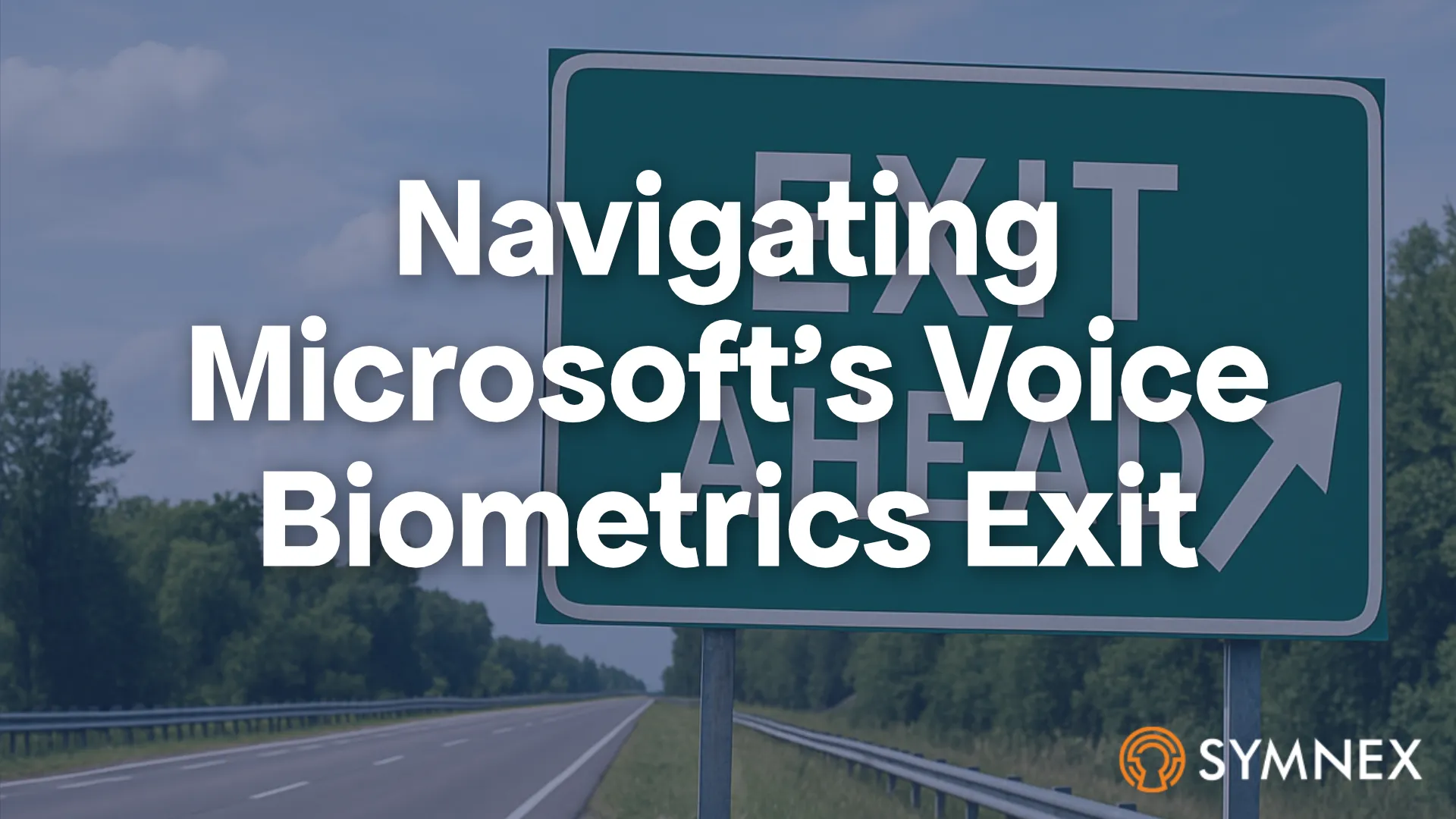This is a follow up to my series on Microsoft's Voice Biometrics Exit:
- Part 1: What is Microsoft's Voice Biometric Endgame? - Why Microsoft will exit
- Part 2: Navigating Microsoft's Voice Biometrics Exit - Why act now
- Part 3: Voice Biometrics Partner Selection and Migration - How to transition strategically
My recent series examining Microsoft's ambitions (or lack of) for voice biometricsVoice Biometrics uses the unique properties of a speakers voice to confirm their identity (authentication) or identify them from a group of known speakers (identification). sparked considerable discussion across the industry. As well as the expected responses from organisations planning their transitions, I've had particularly engaging conversations with vendors trying to understand how this reshuffling creates opportunities.
The more I think about it, the more I’m reminded of a horse race (albeit a slightly chaotic one that nobody expected to be a race at all). So I’ll use that analogy to describe how I currently see the market.
Related Posts
The Unexpected Starting Gun
When Microsoft acquired Nuance in 2022, the enterprise voice biometricsVoice Biometrics uses the unique properties of a speakers voice to confirm their identity (authentication) or identify them from a group of known speakers (identification). market appeared settled. Nuance dominated with SecuritySecurity is one of three key measures of Call Centre Security process performance. It is usually expressed as the likelihood that the process allows someone who isn't who they claim to be to access the service (False Accept). Suite and was migrating customers to their Gatekeeper platform, a handful of alternatives competed for what was left, Amazon offered Voice ID for Connect customers, and various specialists served niche requirements. The market felt mature and predictable.
Microsoft's apparent retreat, with wave after wave of restructuring and lack of communication, created suspicion that there might be a race. But it was Amazon who fired the starting gun with their end of support announcement for Voice ID in May 2025. Google, meanwhile, appears to have quietly left the track altogether, redirecting their Speaker ID pages and removing all references to their solution sometime in July. Suddenly, vendors find themselves in an unplanned race for potentially hundreds of customer opportunities.
Runners and Riders
With such an unexpected start, the line-up and form of competitors isn’t yet completely clear. Some experienced talent (I’m calling them the jockeys) from Microsoft and Nuance, with extensive networks and experience of completing these deal cycles have already selected their horses (the vendors) but others are still evaluating their options: whether to join existing vendors, start fresh, or advise customers on alternatives.
Some horses had a rolling start and are already charging toward the first fence, pursuing early customer wins, from those organisations facing Amazon Connect Voice ID's timeline pressures.
Adding to the confusion, on the start line, Microsoft has started discussing voice biometricsVoice Biometrics uses the unique properties of a speakers voice to confirm their identity (authentication) or identify them from a group of known speakers (identification). capabilities for their Dynamics Contact Centre platform with existing clients. My read is that this is likely to follow Amazon's lightweight and ‘good-enough’ approach, rather than addressing the more sophisticated requirements of current Gatekeeper users. Unfortunately, the marketing narrative may convince some organisations that there might not be a race at all.
The competitive field is still forming. Some entirely new vendors from related sectors may decide to enter, whilst others may fall at the early fences and discover that winning requires capabilities or stamina they lack. To stay the distance, some vendors will also need significant investment. There will be dozens of fences to jump as each Gatekeeper customer comes up for renewal, slowly sapping reserves before many of the largest, hardest and most valuable, customers come up for renewal in three to five years.
Related Services
Different Customers, Different Winners
Here's where my racing analogy starts to fall down: with potentially hundreds of customer opportunities in play, there will likely be multiple winners in this transition.
The voice biometricsVoice Biometrics uses the unique properties of a speakers voice to confirm their identity (authentication) or identify them from a group of known speakers (identification). market isn't monolithic. Some organisations require lightweight authenticationAuthentication is the call centre security process step in which a user's identity is confirmed. We check they are who they claim to be. It requires the use of one or more authentication factors. API solutions similar to Amazon Connect Voice ID that they can then orchestrate in their applications. Others need a full stack of authentication and fraud detection with the associated user and management interfaces, including tens of thousands of call centre agents. Some have clear on-premises or sovereign data requirements and others are more flexible. Many organisations’ telephony platforms are modern and cloud based, but some of the largest and most valuable have complex hybrid platforms that make integration challenging.
This variety suggests that different customers will naturally select different vendors. A cloud-native service perfect for one organisation might be entirely inadequate for another requiring on-premises deployment. The vendor that wins the largest financial services implementation may struggle with the dozens of smaller call centres seeking simple turnkey solutions.
Vendor Opportunities
Organisations on multi-year contracts aren't under immediate pressure, allowing for considered vendor evaluation rather than rushed decisions. Vendors have time to get their products and propositions in order, rather than rushing incomplete solutions to market.
For several vendors, this represents an unexpected lifeline, whilst technically capable they have historically struggled to win deals against Nuance/Microsoft’s dominance and have struggled with profitability and return on investment. Now the playing field is levelling, they don’t need to win every potential customers to build sustainable businesses around what is a fundamentally mature technology. A successful voice biometricsVoice Biometrics uses the unique properties of a speakers voice to confirm their identity (authentication) or identify them from a group of known speakers (identification). business today is as much about execution and scalability as innovation.
Many organisations will naturally approach this as a technology replacement project rather than business change. As a result, when choosing a replacement, they will rightly prioritise factors that reduce implementation risk and seek to achieve a cost advantage. Establishing an early record of success and an effective commercial model will be critical for vendors looking to go the distance.
Subscribe for New Content
Buyer Risks
For buyers, this disconnect from business users and the understanding of the original trade-offs made by their predecessors is the biggest risk. The vendor with the slickest demo, platform certifications and most comprehensive feature lists might not be the most adaptable as the threat landscape changes or more fundamentally partner with you to unlock unrealised value from your application of the technology.
From my perspective, the sad reality is that this won't change much for the end-users of this technology, the customers calling these call centres. Unless organisations use this disruption as an opportunity to examine their business processes, they'll just be swapping one vendor for another.
It’s sad because I suspect that for many organisations this entire procurement effort could be paid for from the efficiencyEfficiency is one of three measures of Call Centre Security process performance. It represents the actual and opportunity cost of the security process, for example the costs of agent time spent on manual authentication or the missed opportunity for self-service. and securitySecurity is one of three key measures of Call Centre Security process performance. It is usually expressed as the likelihood that the process allows someone who isn't who they claim to be to access the service (False Accept). gains from higher enrolmentEnrolment is a step in the registration process where specific utterances are requested from the user or previously acquired audio is used to create a Voice Biometric template (Voiceprint) for subsequent use in Authentication/Identification. and authenticationAuthentication is the call centre security process step in which a user's identity is confirmed. We check they are who they claim to be. It requires the use of one or more authentication factors. rates or fraud reduction. As most deals are based on transactional volumes that would naturally increase alongside usage, this could be a huge win for vendors. Unfortunately, most are focused on feature parity, sales and marketing rather than collaboration, and often lack the capability to do so.
The real opportunity lies in applying the experience and best practices that have matured since many original implementations. In the consentConsent is a step in the registration process where a user provides permission to process their biometric data before enrolment in a Voice Biometric system in a way which complies with applicable data protection and privacy legislation. and enrolment process, for example, some organisations success rates are more than double their peers. Many organisations initial focus on maximising enrolment didn’t get fully operationalised, and opportunities to extend capabilities to other channels (such as capturing consent through mobile apps) or use cases (such as authentication in natural language IVRs) were either abandoned or have only recently emerged.
Related Services
What This Means
Watching this unfold is fascinating, though I suspect vendors actively competing for opportunities and organisations forced to go to market find it less so. It’s difficult to pick the winners this far out, and fortunately, I don’t have to. Right now, no one vendor has a feature complete solution that will drop in for every customer, although several have all the building blocks for success. It’s clear, to me, that this won't be a simple case of one vendor replacing Microsoft/Nuance or Amazon across all customers.
The missed opportunity is that most of this will be treated as technology substitution rather than business improvement. Organisations forced into this procurement cycle should examine how voice biometricsVoice Biometrics uses the unique properties of a speakers voice to confirm their identity (authentication) or identify them from a group of known speakers (identification). fits into their broader operational goals, not just which vendor to choose. There is no better time to make these changes than when the hood is up (sorry — I don’t think there is a horse racing comparison for that). Use this disruption to refocus on the outcomes you are trying to achieve with the technology: quicker, easier and more secure voice channel interactions, and select partners that can collaborate with you to get there.
Some vendors will clearly not make the distance, but every organisation (and it’s customers) could be a winner if we use this opportunity to improve caller experience as well.
Subscribe for New Content
How I Can Help
I've helped dozens of organisations implement and refresh their voice biometrics capabilities. I provide independent advice and will help you apply the best practices learnt from some of the most successfull deployments of this technology to your current and planned investments. I'll help you understand the whole of the market, which vendors are most relevant, where they excel and the reality behind their claims. I'll also work with you to understand where your own internal capabilties will be needed to close the gap and be confident of success.
You can book a time here or contact me directly to discuss your specific situation.


